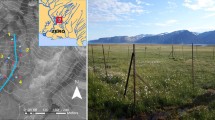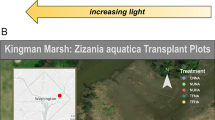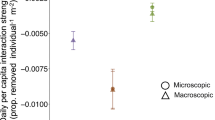Abstract
Herbivores have strong impacts on marine and terrestrial plant communities, but their impact is less well studied in benthic freshwater systems. For example, North American beavers (Castor canadensis) eat both woody and non-woody plants and focus almost exclusively on the latter in summer months, yet their impacts on non-woody plants are generally attributed to ecosystem engineering rather than herbivory. Here, we excluded beavers from areas of two beaver wetlands for over 2 years and demonstrated that beaver herbivory reduced aquatic plant biomass by 60%, plant litter by 75%, and dramatically shifted plant species composition. The perennial forb lizard’s tail (Saururus cernuus) comprised less than 5% of plant biomass in areas open to beaver grazing but greater than 50% of plant biomass in beaver exclusions. This shift was likely due to direct herbivory, as beavers preferentially consumed lizard’s tail over other plants in a field feeding assay. Beaver herbivory also reduced the abundance of the invasive aquatic plant Myriophyllum aquaticum by nearly 90%, consistent with recent evidence that native generalist herbivores provide biotic resistance against exotic plant invasions. Beaver herbivory also had indirect effects on plant interactions in this community. The palatable plant lizard’s tail was 3 times more frequent and 10 times more abundant inside woolgrass (Scirpus cyperinus) tussocks than in spatially paired locations lacking tussocks. When the protective foliage of the woolgrass was removed without exclusion cages, beavers consumed nearly half of the lizard’s tail leaves within 2 weeks. In contrast, leaf abundance increased by 73–93% in the treatments retaining woolgrass or protected by a cage. Thus, woolgrass tussocks were as effective as cages at excluding beaver foraging and provided lizard’s tail plants an associational refuge from beaver herbivory. These results suggest that beaver herbivory has strong direct and indirect impacts on populations and communities of herbaceous aquatic plants and extends the consequences of beaver activities beyond ecosystem engineering.






Similar content being viewed by others
References
Atsatt PR, O’Dowd DJ (1976) Plant defense guilds. Science 193:24–29
Barnes DM, Mallik AU (2001) Effects of beaver, Castor canadensis, herbivory on streamside vegetation in a northern Ontario watershed. Can Field Nat 115:9–21
Brown BJ, Ewel JJ (1987) Herbivory in complex and simple tropical successional ecosystems. Ecology 68:108–116
Carpenter SR, Lodge DM (1986) Effects of submersed macrophytes on ecosystem processes. Aquat Bot 26:341–370
Crain CM, Bertness ND (2005) Community impacts of a tussock sedge: Is ecosystem engineering important in benign habitats? Ecology 86:2695–2704
Crawley MJ (1989) The relative importance of vertebrate and invertebrate herbivores in plant population dynamics. In: Bernays EA (ed) Insect–plant interactions, vol I. CRC, Boca Raton, Fla., pp 45–71
Cyr H, Pace ML (1993) Magnitude and patterns of herbivory in aquatic and terrestrial ecosystems. Nature 361:148–150
Doucet CM, Fryxell JM (1993) The effect of nutritional quality on forage preference by beavers. Oikos 67:201–208
Ervin GN (2005) Spatio-temporally variable effects of a dominant macrophyte on vascular plant neighbors. Wetlands 25:317–325
Ervin GN, Wetzel RG (2002) Influence of a dominant macrophyte, Juncus effusus, on wetland plant species richness, diversity, and community composition. Oecologia 130:626–636
Fryxell JM, Doucet CM (1993) Diet choice and the functional response of beavers. Ecology 74:1297–1306
Galatowitsch SM, Anderson NO, Ascher PD (1999) Invasiveness in wetland plants in temperate North America. Wetlands 19:733–755
Gallant D, Berube CH, Tremblay E, Vasseur L (2004) An extensive study of the foraging ecology of beavers (Castor canadensis) in relation to habitat quality. Can J Zool/Rev Can Zool 82:922–933
Hay M (1986) Associational plant defenses and the maintenance of species diversity: turning competitors into accomplices. Am Nat 128:617–641
Hay M (1992) The role of seaweed chemical defenses in the evolution of feeding specialization and in the mediation of complex interactions. In: Paul V (eds) Ecological roles of marine natural products. Comstock Publishing, Ithaca, N.Y., pp 93–117
Hay M, Kicklighter C (2001) Grazing, effects of encyclopedia of biodiversity, vol 3. Academic Press, New York, pp 265–276
Hay M, Steinberg P (1992) The chemical ecology of plant–herbivore interactions in marine versus terrestrial communities. In: Rosenthal G, Berenbaum M (eds) Herbivores: their interactions with secondary metabolites. Evolutionary and ecological processes, 2nd edn. Academic Press, San Diego, Calif., pp 371–413
Hay ME (1997) The ecology and evolution of seaweed-herbivore interactions on coral reefs. Coral Reefs 16:S67–S76
Hay ME, Kubanek J (2002) Community and ecosystem level consequences of chemical cues in the plankton. J Chem Ecol 28:2001–2016
Huntly N (1991) Herbivores and the dynamics of communities and ecosystems. Annu Rev Ecol Syst 22:477–503
Hutchinson GE (1975) A treatise on limnology: limnological botany. Wiley, New York
Jenkins SH (1980) Seasonal and year-to-year differences in food selection by beavers. Oecologia 44:112–116
John DM, Hawkins SJ, Price JT (eds) (1992) Plant–animal interactions in the marine benthos. Clarendon Press, Oxford
Jones C, Lawton J, Shachak M (1994) Organisms as ecosystem engineers. Oikos 69:373–386
Keane RM, Crawley MJ (2002) Exotic plant invasions and the enemy release hypothesis. Trends Ecol Evol 17:164–170
Kubanek J, Fenical W, Hay ME, Brown PJ, Lindquist N (2000) Two antifeedant lignans from the freshwater macrophyte Saururus cernuus. Phytochemistry 54:281–287
Kubanek J, Hay ME, Brown PJ, Lindquist N, Fenical W (2001) Lignoid chemical defenses in the freshwater macrophyte Saururus cernuus. Chemoecology 11:1–8
Levine JM (2000) Complex interactions in a streamside plant community. Ecology 81:3431–3444
Lodge D, Cronin G, Donk Ev, Froelich A (1998) Impact of herbivory on plant standing crop: comparisons among biomes, between vascular and nonvascular plants, and among freshwater herbivore taxa. In: Jeppesen E, Sondergaard M, Sondergaard M, Christofferson K (eds) The structuring role of submerged macrophytes in lakes. Springer, Berlin Heidelberg New York, pp 149–174
Lubchenco J, Gaines S (1981) A unified approach to marine plant–herbivore interactions. I. Populations and communities. Annu Rev Ecol Syst 12:405–437
Maron JL, Vila M (2001) When do herbivores affect plant invasion? Evidence for the natural enemies and biotic resistance hypotheses. Oikos 95:361–373
Martinsen GD, Driebe EM, Whitham TG (1998) Indirect interactions mediated by changing plant chemistry: beaver browsing benefits beetles. Ecology 79:192–200
McAuliffe JR (1986) Herbivore-limited establishment of a Sonoran desert tree, Cercidium microphyllum. Ecology 67:276–280
McNaughton SJ (1978) Serengeti ungulates: feeding selectivity influences effectiveness of plant defense guilds. Science 199:806–807
Milchunas DG, Noy-Meir I (2002) Grazing refuges, external avoidance of herbivory and plant diversity. Oikos 99:113–130
Muller-Schwarze D, Sun L (2003) The beaver. Cornell University Press, Ithaca, N.Y.
Naiman RJ, Johnston CA, Kelley JC (1988) Alteration of North American streams by beaver. BioScience 38:753–762
Naiman RJ, Pinay G, Johnston CA, Pastor J (1994) Beaver influences on the long-term biogeochemical characteristics of boreal forest drainage networks. Ecology 75:905–921
Newman RM (1991) Herbivory and detritivory on freshwater macrophytes by invertebrates—a review. J North Am Benthol Soc 10:89–114
Parker JD, Burkepile DE, Hay ME (2006a) Opposing effects of native and exotic herbivores on plant invasions. Science 311:1459–1461
Parker JD, Collins DO, Kubanek J, Sullards MC, Bostwick D, Hay ME (2006b) Chemical defenses promote persistence of the aquatic plant Micranthemum umbrosum. J Chem Ecol 32:815–833
Parker JD, Hay ME (2005) Biotic resistance to plant invasions? Native herbivores prefer non-native plants. Ecol Lett 8:959–967
Pollock MM, Heim M, Werner D (2003) Hydrologic and geomorphic effects of beaver dams and their influence on fishes. Am Fish Soc Symp 37:213–233
Ray AM, Rebertus AJ, Ray HL (2001) Macrophyte succession in Minnesota beaver ponds. Can J Bot/Rev Can Bot 79:487–499
Rosenthal GA, Berenbaum MR (eds) (1992) Herbivores: their interactions with secondary metabolites: evolutionary and ecological processes. Academic Press, San Diego, Calif.
Rosine WN (1955) The distribution of invertebrates on submerged aquatic plant surfaces in Muskee Lake, Colorado. Ecology 36:308–314
Schupp PJ, Paul VJ (1994) Calcium carbonate and secondary metabolites in tropical seaweeds: variable effects on herbivorous fishes. Ecology 75:1172–1185
Shelford VW (1918) Conditions of existence. In: Ward HB, Whipple GC (eds) Freshwater biology. Wiley, New York, pp 21–60
Srivastava DS, Jefferies RL (1996) A positive feedback: herbivory, plant growth, salinity, and the desertification of an Arctic salt-marsh. J Ecol 84:31–42
Svendsen GE (1980) Seasonal change in feeding patterns of beaver in southeastern Ohio. J Wildl Manage 44:285–290
Tahvanainen JO, Root RB (1972) Influence of vegetational diversity on population ecology of a specialized herbivore, Phyllotreta cruciferae (Coleoptera: Chrysomelidae). Oecologia 10:321–346
Tevis L (1950) Summer behavior of a family of beavers in New York State. J Mammal 31:40–65
Vannote RL, Minshall GW, Cummins KW, Sedell JR, Cushing CE (1980) River continuum concept. Can J Fish Aquat Sci 37:130–137
Wahl M, Hay ME (1995) Associational resistance and shared doom—effects of epibiosis on herbivory. Oecologia 102:329–340
White JA, Whitham TG (2000) Associational susceptibility of cottonwood to a box elder herbivore. Ecology 81:1795–1803
Wright JP, Flecker AS, Jones CG (2003) Local vs. landscape controls on plant species richness in beaver meadows. Ecology 84:3162–3173
Wright JP, Jones CG, Flecker AS (2002) An ecosystem engineer, the beaver, increases species richness at the landscape scale. Oecologia 132:96–101
Acknowledgements
We thank T. Bronikowski, D. Burkepile, A. Chequer, and W. Morrison for field help. A. Agrawal and two anonymous reviewers provided helpful comments on the manuscript. This research was supported by the National Science Foundation, the National Park Service, the MidSouth Aquatic Plant Management Society, and a Harry and Linda Teasley endowment to Georgia Tech. All experiments complied with the current laws of the United States.
Author information
Authors and Affiliations
Corresponding author
Additional information
Communicated by John Keeley.
Rights and permissions
About this article
Cite this article
Parker, J.D., Caudill, C.C. & Hay, M.E. Beaver herbivory on aquatic plants. Oecologia 151, 616–625 (2007). https://doi.org/10.1007/s00442-006-0618-6
Received:
Accepted:
Published:
Issue Date:
DOI: https://doi.org/10.1007/s00442-006-0618-6




